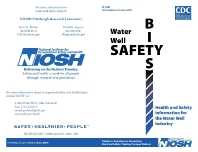Mining Publication: Water Well Safety Bits: Health And Safety Information For The Water Well Industry
Original creation date: September 2005
Water well drillers are exposed to high levels of noise while working. NIOSH researchers have found that water well drillers are exposed to levels above 85dB(A) while performing certain tasks during a typical drilling job. Noise levels consistently over 85dB(A) during an 8-hour work shift are hazardous and can lead to hearing loss in workers. Finding ways to reduce noise exposure is difficult because of many factors. The work environment is constantly changing due to the location of jobs and environmental factors. The types of drill rigs required for drilling are expensive. Equipment can range from new to used (10 to 30+ years old). Drillers and owners can work together to prevent noise-induced hearing loss, and measures can be taken to reduce exposure to hazardous noise.
Authors: DC Reinke
Information Circular - September 2005
NIOSHTIC2 Number: 20028437
Pittsburgh, PA: U.S. Department of Health and Human Services, Public Health Service, Centers for Disease Control and Prevention, National Institute for Occupational Safety and Health, DHHS (NIOSH) Publication No. 2005-160, Information Circular 9483, 2005 Sep; :1-15
See Also
- Analysis of a Mechanism Suspension to Reduce Noise from Horizontal Vibrating Screens
- Cross-Sectional Survey of Noise Exposure in the Mining Industry
- Determination of Sound Exposures (DOSES): Software Manual and Implementation Guide
- The Evolution of Drill Bit and Chuck Isolators to Reduce Roof Bolting Machine Drilling Noise
- A Noise Control for A Roof Bolting Machine: Collapsible Drill Steel Enclosure
- Noise Control in Underground Metal Mining
- Noise Exposure in Longwall Mining and Engineering Controls Research
- Snapshot of Noise and Worker Exposures in Sand and Gravel Operations
- Technology News 536 - NIOSH Develops New Software to Analyze and Reduce Noise Exposure
- What Does a Hearing Loss Sound Like?
- Content source: National Institute for Occupational Safety and Health, Mining Program


 ShareCompartir
ShareCompartir
